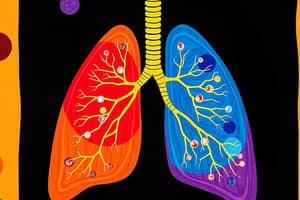Podcast
Questions and Answers
What is the main function of the respiratory zone in the lungs?
What is the main function of the respiratory zone in the lungs?
- Warming inspired air
- Humidifying inspired air
- Filtering out dust particles from inspired air
- Gaseous exchange between oxygen and carbon dioxide (correct)
Which component of the respiratory zone is responsible for increasing the surface area available for gas diffusion?
Which component of the respiratory zone is responsible for increasing the surface area available for gas diffusion?
- Respiratory bronchioles
- Alveoli (correct)
- Alveolar ducts
- Alveolar sacs
What are the walls of alveoli lined with, making them highly efficient for gas exchange?
What are the walls of alveoli lined with, making them highly efficient for gas exchange?
- Stratified epithelium
- Ciliated epithelium
- Squamous epithelium (correct)
- Columnar epithelium
Which structure directly leads into the alveolus?
Which structure directly leads into the alveolus?
Which component of the respiratory zone is crucial for pulmonary gas exchange?
Which component of the respiratory zone is crucial for pulmonary gas exchange?
How many alveoli are present in each healthy adult lung approximately?
How many alveoli are present in each healthy adult lung approximately?
What is the function of alveolar sacs in the respiratory system?
What is the function of alveolar sacs in the respiratory system?
Which structure in the respiratory system allows for more extensive branching, leading to an increase in the number of alveoli per lung unit volume?
Which structure in the respiratory system allows for more extensive branching, leading to an increase in the number of alveoli per lung unit volume?
What facilitates the diffusion of gases like oxygen and carbon dioxide across the alveolar wall efficiently during pulmonary gas exchange?
What facilitates the diffusion of gases like oxygen and carbon dioxide across the alveolar wall efficiently during pulmonary gas exchange?
Which part of the respiratory system is responsible for enhancing the distribution of oxygen and carbon dioxide by providing even greater surface area for gas exchange?
Which part of the respiratory system is responsible for enhancing the distribution of oxygen and carbon dioxide by providing even greater surface area for gas exchange?
What is the role of respiratory bronchioles in the respiratory system?
What is the role of respiratory bronchioles in the respiratory system?
How do alveolar ducts contribute to the efficiency of gas exchange in the lungs?
How do alveolar ducts contribute to the efficiency of gas exchange in the lungs?
Study Notes
Respiratory Zone Overview
The respiratory zone is a region within our lungs where oxygen from the air we breathe is exchanged with carbon dioxide produced by cellular metabolism. This process of gas exchange occurs primarily between the alveoli and the surrounding capillaries. The human lung can be divided into two main zones—the conducting zone and the respiratory zone. While the former handles the physical processes such as filtering out dust particles, warming, and humidifying inspired air, the latter is responsible specifically for gaseous exchange, which is crucial for life itself.
In this article, we will delve deeper into the components of the respiratory zone—alveoli, respiratory bronchioles, alveolar ducts, alveolar sacs, and the critical function of pulmonary gas exchange.
Components of the Respiratory Zone
Alveoli
Alveoli are small, air-filled sacs found at the end of the bronchioles, extending throughout both lobes of the lung. They have very thin walls lined by squamous epithelium, making them highly efficient for gas exchange. There are around half a billion alveoli present in each healthy adult lung, which collectively increase the surface area available for gas diffusion, allowing up to 5 liters of air to diffuse across these membranes every minute.
Respiratory Bronchioles
These are narrower branches of the bronchioles that lead directly into the alveolus. Their reduction in diameter allows for more extensive branching, thus increasing the number of alveoli per lung unit volume.
Alveolar Ducts
The distal branches of the respiratory bronchioles give rise to the alveolar ducts, which eventually terminate at the alveolar sacs. These structures allow for further subdivision and expansion of the lung tissue, enhancing its overall efficiency for gas exchange.
Alveolar Sacs
At the end of the alveolar ducts, there are clusters of grape-like formations called alveolar sacs. These sacs are composed of numerous alveoli, providing even greater surface area for gas exchange.
Pulmonary Gas Exchange
Pulmonary gas exchange occurs when oxygen from the inspired air diffuses through the alveolar wall, into the bloodstream, and from there into the body's tissues, while carbon dioxide moves in the opposite direction from the tissues back into the bloodstream and ultimately into the lungs. Since the partial pressures of O2 and CO2 differ significantly across these barriers, diffusion of these gases takes place quite efficiently due to their high solubility in water.
This process ensures that the body maintains a constant supply of oxygen needed for energy production and the removal of waste products like carbon dioxide, which would otherwise accumulate and cause acidosis if not expelled regularly.
In summary, the respiratory zone comprises specialized structures designed for optimal gas exchange. From the alveoli, which provide a vast surface area for efficient transfer of oxygen and carbon dioxide, to the respiratory bronchioles, alveolar ducts, and alveolar sacs, which enhance the distribution of these gases, the respiratory zone plays a crucial role in maintaining homeostasis within the human body.
Studying That Suits You
Use AI to generate personalized quizzes and flashcards to suit your learning preferences.
Description
Test your knowledge on the components of the respiratory zone, including alveoli, respiratory bronchioles, alveolar ducts, alveolar sacs, and the process of pulmonary gas exchange. Learn about the specialized structures that facilitate efficient gas exchange in the lungs.




